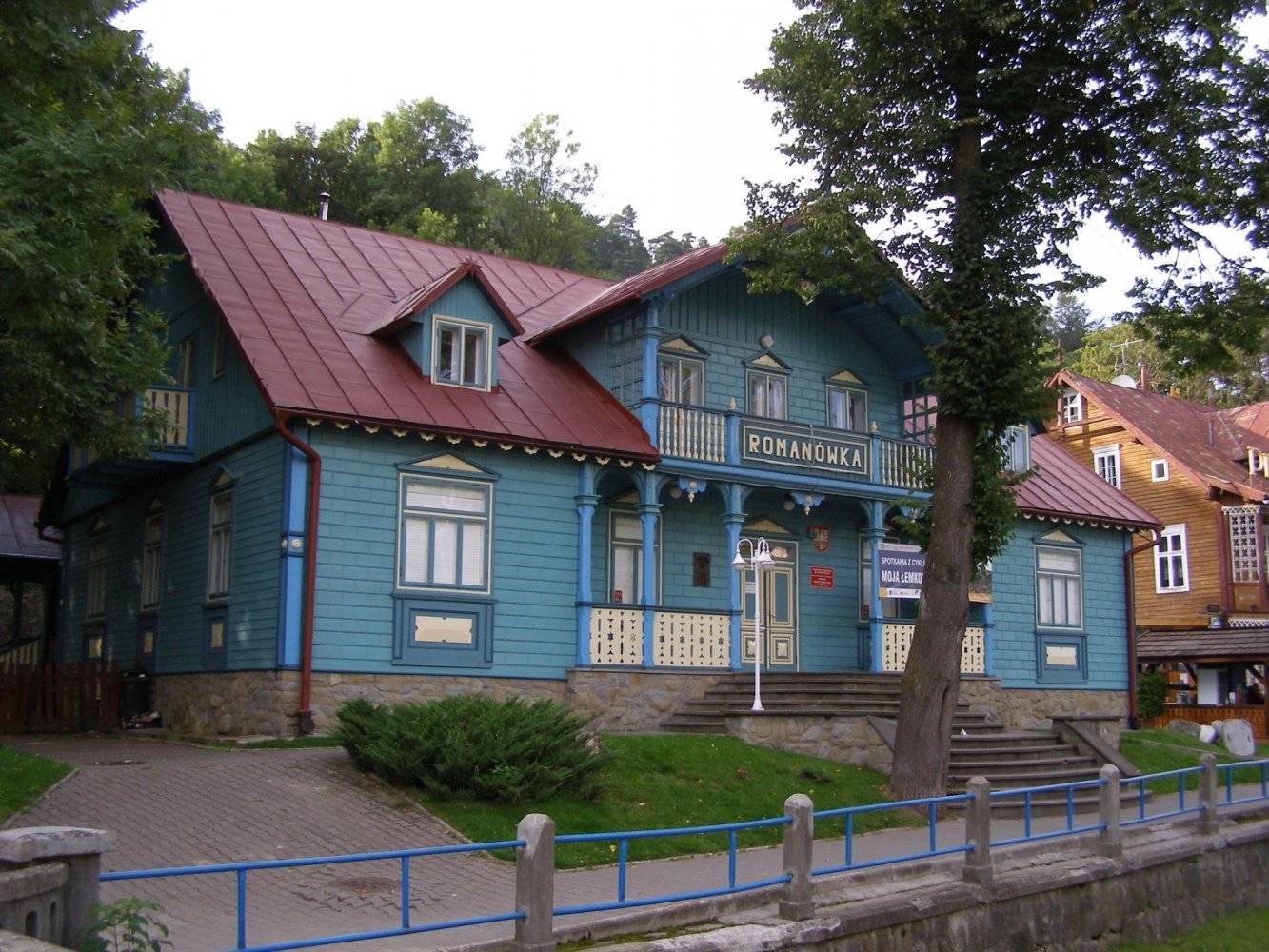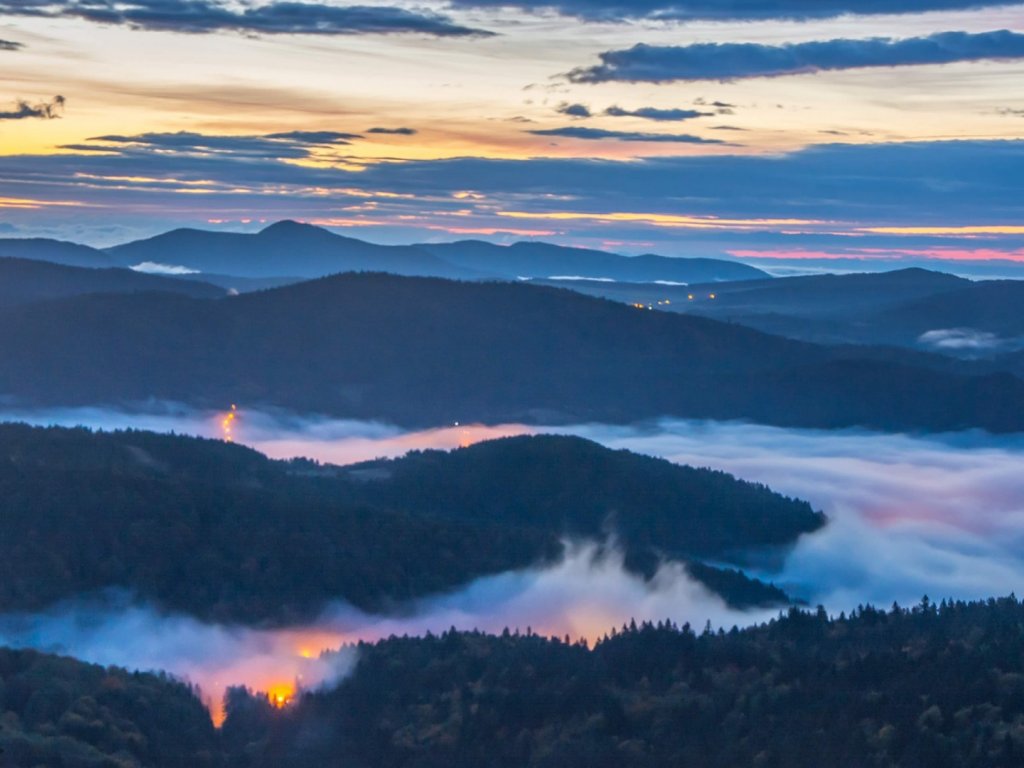The building, formerly located on Piłsudskiego Street until 1990, was demolished and, after conservation repairs in the years 1992-1994, reconstructed on a new site in the town centre, on Dietl Boulevard, opposite the Old Spa House. The museum broadly presents the work of one of the world's most famous painters of intuitive painting, Nikifor (circa 1895-1968), who lived in Krynica almost all his life. The exhibition contains paintings from all of his artistic periods: watercolours, gouaches and drawings of various themes typical for the artist's work: landscapes with Orthodox and Catholic churches, architecture of Krynica, interiors, railway stations, offices, "dollar factories", portraits etc. The documentary part of the exhibition consists of Nikifor's memorabilia, publications devoted to the painter and his photographs.
The museum also hosts exhibitions by well-known non-professional and folk artists.
The opening of Nikifor Museum was considered the most interesting museum event of 1995. It gathers paintings and memorabilia of Nikifor, a self-taught painter born around 1895, whose works "discovered" in the 1930s, called naive art, became famous also outside Poland. Nikifor, who lived whole life in Krynica and was called Krynicki from 1962, left behind more than 2000 watercolours. On paper, cardboard, boxes etc. he usually painted very colourful cityscapes, buildings, churches, less often religious scenes and portraits, and signed his pictures with signatures, which are meaningless sets of letters.
The museum exhibits 77 works by Nikifor, mostly from the period between the wars, considered the best in his artistic output. Visitors can also see his modest painting workshop, the famous chest in which he kept all his belongings, the stamps he used to make himself, and the photographs of the artist from the last 10 years of his life (the only ones he had) taken by his legal guardian, an artist Marian Wosinski. On display are also books and articles by Polish and foreign authors about Nikifor, posters, exhibition catalogues and invitations to exhibitions. The museum is also a place where exhibitions of well-known artists from the circle of non-professional and folk art are held.
Open:
Tuesday - Saturday 10:00 am - 1:00 pm, 2:00 pm - 5:00 pm
Sunday 10:00 am - 3:00 pm 19
Bulwary Dietla, 33-380 Krynica
tel:18 471 53 03
Museum of Toys
Since 15 July 2010, there is a new museum in Krynica-Zdrój. In several rooms in the basement of the New Mineral Baths, the "Bajka" Toy Museum was opened. The exposition in Krynica is a branch of a similar museum in Kudowa-Zdrój (established in 2002). It is the fourth facility of this kind in our country and the owner and initiator of the museum is Mrs. Maria Ozierańska.
The oldest toys presented in Krynica come from prehistoric times. They were found during archaeological excavations in Elbląg. The rest of the collection was created in the 19th century and the beginning of the 20th century.
The collections of the Bajka Toy Museum include all forms of toy-making: a beautiful collection of historical toys, regional toys and many others, once loved by their owners "the most important in the world", and now standing proudly in display cases in all their glory.
The museum is open every day except for the first day of Easter, 1 XI and 25 XII e
very day from 10:00 am to 5.00 pm
holidays from 9.00 am to 6.00 pm
Toy Museum "Bajka" Kudowa Zdrój Branch in Krynica Zdrój
2 Piłsudskiego Street - Nowe Łazienki Mineralne
33-380 Krynica Zdrój
tel.: 693 634 114, 783 783 139
e-mail: krynica@muzeum-zabawek.pl
www.muzeum-zabawek.pl
The Museum of Mountain Tourism
is one of several museums in the Polish mountains, presenting the history of their exploration and bringing closer the traditions of mountain tourism in Poland and the lands that once belonged to Poland.
The museum on Jaworzyna Krynicka was opened in 1970. Its exhibition is dedicated primarily to the history of tourism in the Beskid Sądecki and partisan fights in the Jaworzyna Krynicka range.
The most precious exhibit in the exhibition is a memorial book dating back to pre-war times. The hostel was burnt down, but the book was saved and preserved to this day. You can see in it the entries of the pioneers of organized mountain tourism in Beskid Sądecki. In the museum there are also showcases dedicated to the most prominent tourist activists. They honour, among others, Kazimierz Sosnowski, who was one of the originators of the Main Beskid Mountain Trail, and Walery Goetel as a co-creator of the border national parks. One of the rooms is dedicated to the history of tourism in Beskid Sądecki, where the achievements of local tourist activists are presented, as well as the genesis of marking trails and building hostels in this area. A separate part of the exhibition concerns the history of partisan fights in this area (Jaworzyna Krynicka Range). They constituted a very important episode of military operations in the region. It is worthwhile, even if only for a moment, stopping off on your wanderings along the routes of the Beskid Sądecki to learn about the rich history of the local mountains and the people connected with them in the Museum of Mountain Tourism on Jaworzyna...
The Museum of Mountain Tourism at the PTTK mountain shelter on Jaworzyna Krynicka
Contact
tel. 18 471 54 09
Private Museum of Nature and Hunting "Łuczakówka"
In Krynica Zdroj, on 37 Halna Street there is a Private Museum of Nature and Hunting "Łuczakówka" founded, organized and run by Mr. Józef Łuczek - nature and hunting enthusiast. In the museum there are several hundred prepared animals, many of them legally protected species. The collection was gathered for over 30 years of hunting, collecting and obtaining gifts. All specimens were prepared by Mr Łuczak for educational purposes. They are carefully stored in glass cases. The museum can be visited from Tuesday to Sunday from 9.00 a.m. to 4.00 p.m. However, it is best to contact Mr Józef in person (507 497 694 or 18 447-51-24) before planning a visit, as the owner will try to show you around and tell you about his collection.
The first room - called by the owner "The Bird Room" there are more than 300 crafted birds, mainly singing, ornamental and game birds. About 80% of them are protected species. The Indian peacock, placed in its full glory on the ceiling of the hall, also makes a great impression.
The second room, called the "Hall of big game and predators", contains a collection of red deer antlers (about 80 pieces) and roe deer antlers (about 250 pieces), elk blades, fallow deer antlers and mouflon antlers. The glass showcases contain specimens of mammals, predators and other large wildlife. Particularly noteworthy are fully prepared Wolves, Wildcat, Otter, Beaver, Raccoon, Wolverine, Lynx. The animal specimens making up the staging are very impressive - including foxes attacking a weakened boar with a broken run or two piglets biting each other.
Those who are keen on safari hunting will not be disappointed. You can see beautifully crafted medallions of animals obtained by Joseph in Namibia at farms in the Kalahari Desert. The medallions include Kudu Oryx - known as the horse antelope, Sprinbok - the jumping antelope, Hartebeest (Buffalo) - the cow antelope, Giraffe and Ostrich. The medallions of the wildebeest and warthog were donated to the museum by a friend with whom they had travelled on safari. In addition to the wildlife trophies, collections of butterflies, stick insects, specimens of three species of African acacia, samples of rock from the desert, and salt rising from the earth's interior in desert regions were also brought back from Africa.
In addition to the collection of animals, the owner has a large collection of replicas of firearms, hunting and military weapons, samples of hunting ammunition from the Swedish company "Norma". At the end of the tour, the owner shows his unique hand-made rifle, the stock of which is entirely covered with deer antlers - very impressive.
Check: Krynica Zdrój what is worth seeing? The most important attractions
















